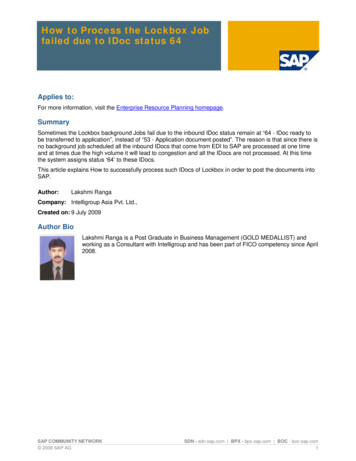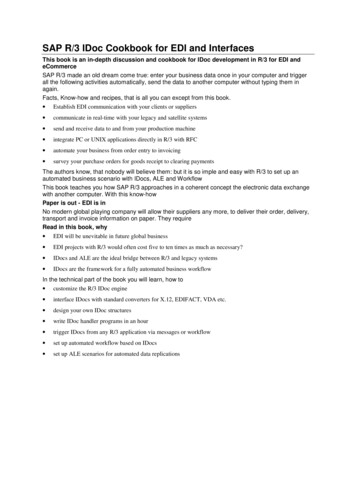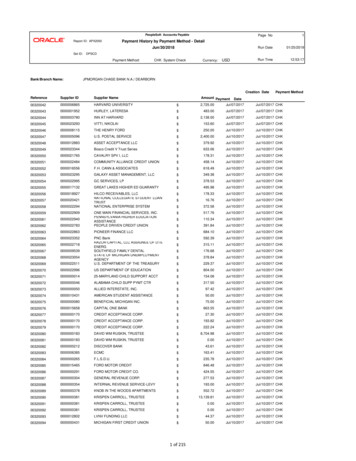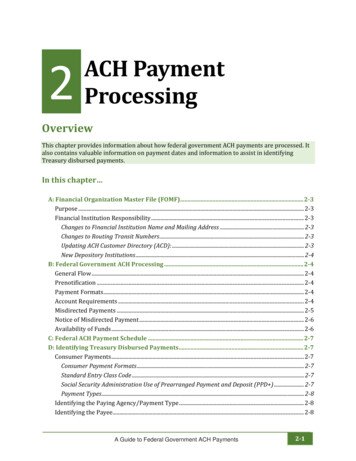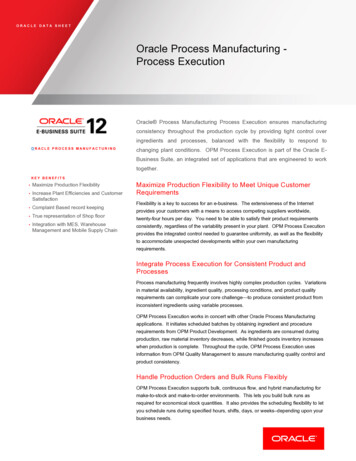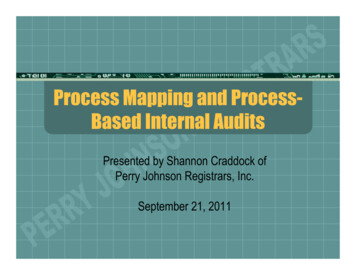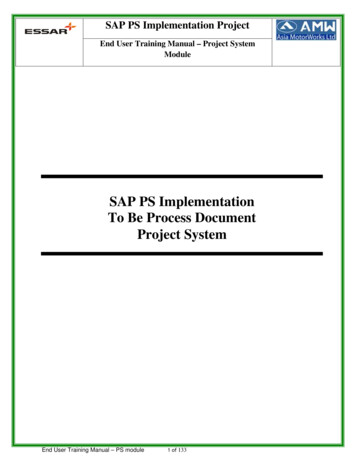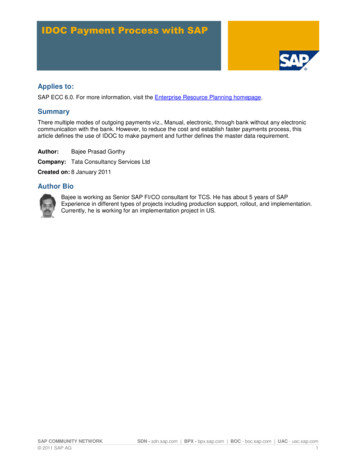
Transcription
IDOC Payment Process with SAPApplies to:SAP ECC 6.0. For more information, visit the Enterprise Resource Planning homepage.SummaryThere multiple modes of outgoing payments viz., Manual, electronic, through bank without any electroniccommunication with the bank. However, to reduce the cost and establish faster payments process, thisarticle defines the use of IDOC to make payment and further defines the master data requirement.Author:Bajee Prasad GorthyCompany: Tata Consultancy Services LtdCreated on: 8 January 2011Author BioBajee is working as Senior SAP FI/CO consultant for TCS. He has about 5 years of SAPExperience in different types of projects including production support, rollout, and implementation.Currently, he is working for an implementation project in US.SAP COMMUNITY NETWORK 2011 SAP AGSDN - sdn.sap.com BPX - bpx.sap.com BOC - boc.sap.com UAC - uac.sap.com1
IDOC Payment Process with SAPTable of ContentsAbstract . 3Payment Processing through IDOCs . 3Introduction to Electronic Payment Processing . 3IDOC-EDI Configuration. 4Payment program configuration for IDOC-EDI payments . 4EDI-Compatible Payment Methods . 4External Payment Method Configuration . 5Processing Remittance Advices through IDOCs . 5Managing Localizations requirements . 7IDOC structure . 7IDOC Control Record Structure . 7IDOC Data Record Structure . 7Benefits of automated IDOC processing . 7Variant in Payment Program. 8Bank Master data management. 9Bank directory: . 9House Bank Data: . 10Account data: . 10EDI Partner profiles: . 11Vendor Bank Data . 12Appendix . 12Related Content . 13Disclaimer and Liability Notice . 14SAP COMMUNITY NETWORK 2011 SAP AGSDN - sdn.sap.com BPX - bpx.sap.com BOC - boc.sap.com UAC - uac.sap.com2
IDOC Payment Process with SAPAbstractPayment to vendor can be made in multiple modes like check, wire transfer, drafts, cash etc. With increasein number of vendors in the organization, processing of individual invoices not only costs more money butalso valuable time in the procure-to-pay cycle. But with the evolution of technology to automate AccountsPayable document processes, it costs some companies more than others.It has been found in a research that top-performing companies process a higher percentage of vendorinvoices electronically in comparison with their peers. Businesses recognize the value of automatingAccounts Payable and are increasingly eager to gain the benefits of automation. From my research, I foundthat major drivers for implementation of automated Accounts Payable are large transaction volumes,pressures to reduce costs, and impact on cash flow. In a multi-national company, particularly, number ofsuppliers is high, transaction volumes are high and, hence, they stand a better chance of cost savings fromautomation of accounts payable process.This paper presents the unique value of a comprehensive platform to streamline Payment process betweencompanies and Banks.There are two key areas that are addressed as a part of this whitepaper: IDOC Payment processingBank master data managementThis paper is designed to assist Accounts Payable managers and SAP implementation team members inlearning, planning and evaluating automated vendor payment processing for increased efficiency in today’scompetitive business environment.Note: Configuration of Payment program and FBZP transaction is not a part of the scope of this document. Thisdocument assumes that the pre-conditions for payment processing have been configured. This includes all thebasic settings and payment program configuration. The document only provides information regarding theincremental configuration that is necessary for IDOC-EDI payments to work.Payment Processing through IDOCsIntroduction to Electronic Payment ProcessingFull electronic payment is an important aspect of electronic commerce. Companies today are moving awayfrom paper checks and manual processing of wire and ACH payments to electronic payments. Almost all thebanks today can accept electronic payment instructions from corporate clients. In addition to this, banks alsoallow for electronic payments for most payment methods such as wires, checks and ACH, as well as localpayment methods in some countries.One way to achieve this integration with banks would be to implement a custom solution by writingcustomized programs to create payment instructions and files which need to be sent to the banks. However,SAP has provided an easier way to implement this functionality by using an SAP IDoc interface. Most bankstoday allow for EDI payment processing through Payment IDOCs. SAP has capabilities to convert IDOCsinto EDI message types or send the IDOCs directly to the bank through EDI medium electronically. Thus thisoption is gaining prominence today for SAP payment processing implementations.SAP COMMUNITY NETWORK 2011 SAP AGSDN - sdn.sap.com BPX - bpx.sap.com BOC - boc.sap.com UAC - uac.sap.com3
IDOC Payment Process with SAPIDOC-EDI ConfigurationThis section contains pointers to the configuration for IDOC-EDI payments.Payment program configuration for IDOC-EDI paymentsa. You must also configure the output of a printed summary sheet for each payment run;b. Select the following forms in the field: FBZP - Paying Company Codes - In EDI Accompanying Sheet Formfield - enter F110 EDI 01c. In transaction FBZP - Pmt methods in company code - select the payment method in the company codeyou want - In the form data field: enter Next Form F110 EDI 01d. You must also specify the variant as RFFOEDI1 in the payment methods configuration. FBZP - Pmtmethods in country - select the payment method in the country you want - assign the variant RFFOEDI1 inthe payment medium program fieldEDI-Compatible Payment MethodsIt is required that the payment program identifies payment methods with which house banks can be used forEDI, before the payments and bank collection can be carried out using EDI. In this step, we specify thesupported EDI payment method for each EDI-capable house bank.Financial Accounting – Accounts Receivable and Accounts Payable – Business Transactions – OutgoingPayments – Payment Media – EDI Payment Orders and Debit Memos – Define EDI-Compatible PaymentMethods for a House BankSAP COMMUNITY NETWORK 2011 SAP AGSDN - sdn.sap.com BPX - bpx.sap.com BOC - boc.sap.com UAC - uac.sap.com4
IDOC Payment Process with SAPExternal Payment Method ConfigurationThe payment methods configured in SAP cannot be identified by the bank as to the type of payment thatneeds to be carried out for a given transaction. Hence banks expect the IDOCs to be populated with bankspecific payment codes. This is done using external payment method ConfigurationFinancial Accounting – Accounts Receivable and Accounts Payable – Business Transactions – OutgoingPayments – Payment Media – EDI Payment Orders and Debit Memos – Assign EDI Payment Method toExternal Payment MethodThe external payment method is the bank specific payment code which will be transmitted as an instructionfor the type of payment to be carried out (e.g. check, ach etc) to the Bank through the IDOC.Processing Remittance Advices through IDOCsCurrent capabilities of SAP allow companies to transmit remittance advice details through IDOCs. As a resultmany banks provide additional functionally which allows the vendors to view the remittance information onthe website once the IDOC has been processed by the bank and the payment has been made. This allowscompanies to do away with manual printing and processingof payment advices which results in reduction in costs and increased efficiency. The indicator commonlyused to instruct the bank to display the remittance advice information online is configured as an instructionkey in SAP configuration and assigned to the vendor in the vendor master. This setting allows companies tomake this capability available for only those vendors who have a high transaction volume. This allowscompanies to keep their bank processing costs at a minimum. In order to instruct the bank to print online theremittance advice for a vendor payment, special instructions need to be configured in SAP. This is doneusing instruction key configuration which is country and payment method specific.SAP COMMUNITY NETWORK 2011 SAP AGSDN - sdn.sap.com BPX - bpx.sap.com BOC - boc.sap.com UAC - uac.sap.com5
IDOC Payment Process with SAPFinancial Accounting – Accounts Receivable and Accounts Payable – Business Transactions –OutgoingPayments – Payment Media – Data Medium Exchange – Define Instruction KeysFor each of these instruction keys, instruction text and code word needs to be defined. These details will beprovided by the bank with which the implementation team is dealing with.Financial Accounting – Accounts Receivable and Accounts Payable – Business Transactions – OutgoingPayments – Payment Media – Data Medium Exchange – Define Instructions for Payment Transactions.These instruction keys are then assigned in the vendor master for each of the vendors for whom thisfunctionality needs to be activated.SAP COMMUNITY NETWORK 2011 SAP AGSDN - sdn.sap.com BPX - bpx.sap.com BOC - boc.sap.com UAC - uac.sap.com6
IDOC Payment Process with SAPManaging Localizations requirementsMost countries have rules regarding the payment file formats, bank account numbers and other countryspecific mandatory data elements that need to be populated in the payment information that is processed bya third party. This information needs to be populated in the IDOC when the payments are generated in SAP.Standard SAP functionality provides for most of the common localizations that exist in different countries.However, care must be taken to match the data in these fields to the requirements provided by the banks.This is because often banks might place additional requirements with regards to what information they wouldlike to see for the localizations in the IDOC. In cases where such information cannot be provided for bystandard IDOC and bank master data set up, customization might be necessary. This can be achieved byusing the user exit EXIT SAPLIEDP 002 (for PAYEXT) to meet the requirementsIDOC structureUnderstanding the payment IDOC structure is the key to a successful implementation. By comparing thestandard IDOC elements with the format required by the bank, the implementation team can identify thecustomizations that are required for successful payment processing. Once IDOC is generated, the structurecan be accessed at transaction WE05.IDOC are split into three main sections Control records – They contain all the information for technicalprocessing Data records – Contain the actual application data Status records – Keep the processing recordsIDOC Control Record StructureThe Control Record contains the administration information for technical processing, as well as the IDoc andmessage type. This information specifies the structure and the content of the next part. Only one controlrecord is generated for one payment run while multiple data records can be generated for the same paymentrun.IDOC
SAP has provided an easier way to implement this functionality by using an SAP IDoc interface. Most banks today allow for EDI payment processing through Payment IDOCs. SAP has capabilities to convert IDOCs into EDI message types or send the IDOCs directly to the bank through EDI medium electronically. Thus thisFile Size: 598KBPage Count: 14
